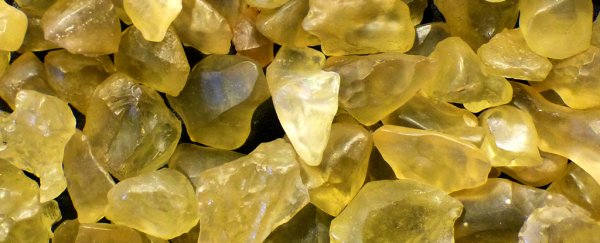A strange kind of yellow, exotic glass found across some of the world's desert regions has finally had its mysterious origins identified – almost 30 million years after it formed on Earth.
Libyan desert glass is a naturally occurring kind of glass that's found in the eastern stretches of the Sahara desert, in eastern Libya and western Egypt. Its rare yellow colour has seen it used decoratively going back to the age of Tutankhamun, but desert glass has been around a lot longer than that.
The formation of this strange glass has been dated as far back as some 29 million years ago, but it's never been entirely clear what forces brought the material into existence on Earth, although two major hypotheses have dominated the conversation.
"It has been a topic of ongoing debate as to whether the glass formed during meteorite impact, or during an airburst, which happens when asteroids called Near Earth Objects explode and deposit energy in the Earth's atmosphere," says geologist and planetary scientist Aaron Cavosie from Curtin University in Australia.
According to Cavosie, previous modelling suggested that Libyan desert glass could have been formed in airburst events much like the dramatic Chelyabinsk explosion that occurred over Russia in 2013.
But new research gives us the first "unequivocal substantiation" that this might not be the case after all.
In a new study, Cavosie examined small grains of the mineral zircon embedded in samples of the Libyan desert glass. The analysis turned up trace evidence of another mineral called reidite, which forms in high pressure, but only during meteorite impacts (as it's found solely in impact craters), not from airbursts.
"Both meteorite impacts and airbursts can cause melting, however, only meteorite impacts create shock waves that form high-pressure minerals," says Cavosie.
"So finding evidence of former reidite confirms it was created as the result of a meteorite impact."
According to the researchers, the reidite identification doesn't just help us close the book on how this ancient desert glass came into being.
It also lets us clarify, with reference to the geological record, just how often destructive shockwave-producing run-ins with NEOs occur on Earth – since there are no confirmed airburst-related glass deposits that were formed within the last 5 million years.
Because we now know only much rarer and major meteorite impact events can produce Libyan desert glass, hopefully it will be another incredible age before this yellow material gets a chance to be fused together on Earth again, as beguiling as it is.
"Meteorite impacts are catastrophic events, but they are not common," says Cavosie.
"Airbursts happen more frequently, but we now know not to expect a Libyan desert glass-forming event in the near future, which is cause for some comfort."
The findings are reported in Geology.
